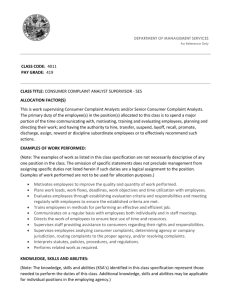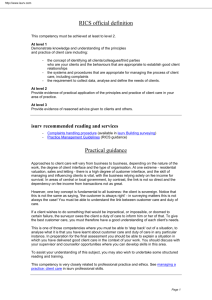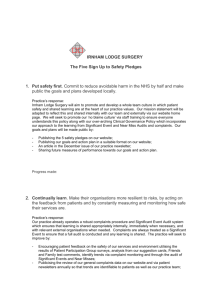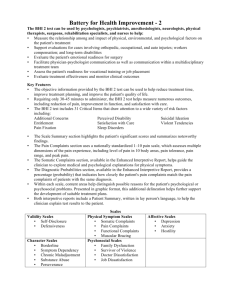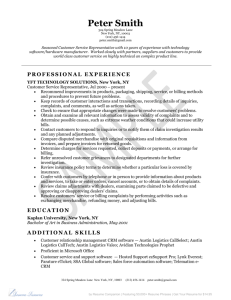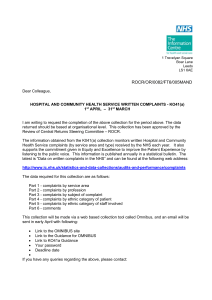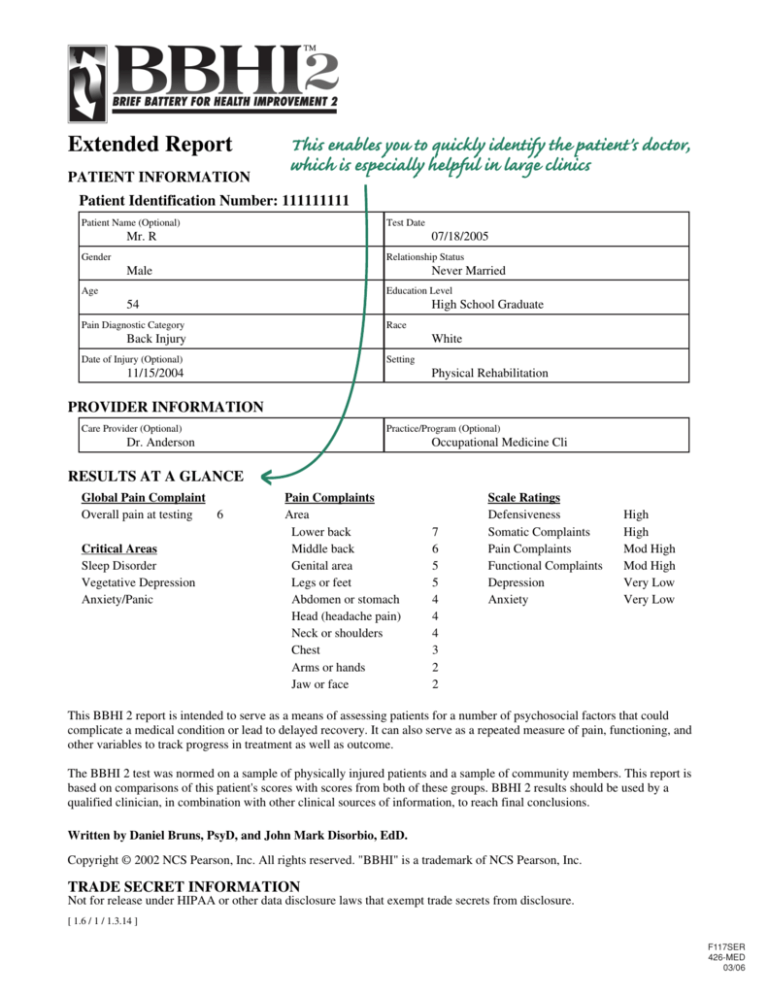
Extended Report
PATIENT INFORMATION
Patient Identification Number: 111111111
Patient Name (Optional)
Test Date
Mr. R
07/18/2005
Gender
Relationship Status
Male
Never Married
Age
Education Level
54
High School Graduate
Pain Diagnostic Category
Race
Back Injury
White
Date of Injury (Optional)
Setting
11/15/2004
Physical Rehabilitation
PROVIDER INFORMATION
Care Provider (Optional)
Practice/Program (Optional)
Dr. Anderson
Occupational Medicine Cli
RESULTS AT A GLANCE
Global Pain Complaint
Overall pain at testing
6
Critical Areas
Sleep Disorder
Vegetative Depression
Anxiety/Panic
Pain Complaints
Area
Lower back
Middle back
Genital area
Legs or feet
Abdomen or stomach
Head (headache pain)
Neck or shoulders
Chest
Arms or hands
Jaw or face
7
6
5
5
4
4
4
3
2
2
Scale Ratings
Defensiveness
Somatic Complaints
Pain Complaints
Functional Complaints
Depression
Anxiety
High
High
Mod High
Mod High
Very Low
Very Low
This BBHI 2 report is intended to serve as a means of assessing patients for a number of psychosocial factors that could
complicate a medical condition or lead to delayed recovery. It can also serve as a repeated measure of pain, functioning, and
other variables to track progress in treatment as well as outcome.
The BBHI 2 test was normed on a sample of physically injured patients and a sample of community members. This report is
based on comparisons of this patient's scores with scores from both of these groups. BBHI 2 results should be used by a
qualified clinician, in combination with other clinical sources of information, to reach final conclusions.
Written by Daniel Bruns, PsyD, and John Mark Disorbio, EdD.
Copyright © 2002 NCS Pearson, Inc. All rights reserved. "BBHI" is a trademark of NCS Pearson, Inc.
TRADE SECRET INFORMATION
Not for release under HIPAA or other data disclosure laws that exempt trade secrets from disclosure.
[ 1.6 / 1 / 1.3.14 ]
F117SER
426-MED
03/06
BBHI™ 2 Extended Report
07/18/2005, Page 2
ID: 111111111
Mr. R
Brief Battery for Health Improvement 2
Scales
Validity Scale
Raw
T Scores
Score Patient Comm.
Defensiveness
19
63
57
Somatic Complaints
Pain Complaints
Functional Complaints
17
42
65
58
57
75
66
69
1
2
34
33
38
37
Physical Symptom Scales
17
Patient Norms Profile
T-Score Profile
40
10
60
Rating
Percentile
High
91%
90%
Mod High
78%
Very Low
5%
Mod High
Very Low
76 %
6%
INTERPRETING THE PROFILE:
[V 1.0]
1 The T-Score Profile plots T scores based on both patient and community norms. Approximately 68% of the samples scored in
the average range of 40 to 60. Scores above or below this range are clinically significant. The longer the bar, the more significantly
the score deviates from the mean. One diamond outside the average range is significant. Both diamonds outside is more significant.
2 The Percentile is based on patient T scores.
CRITICAL ITEMS
The client responded to the following critical items in a manner that is likely to be of concern to the
clinician. The patient's response appears in parentheses after the item.
Sleep Disorder
Omitted Item (Strongly Disagree)
Vegetative Depression
Omitted Item (Big Problem)
Omitted Item (Big Problem)
Anxiety/Panic
Omitted Item (Big Problem)
2
90
High
Affective Scales
Depression
Anxiety
50
1
ITEMS
NOT
SHOWN
Special Note:
The content of the test items
is included in the actual reports.
To protect the integrity of the test,
the item content does not appear
in this sample report.
BBHI™ 2 Extended Report
07/18/2005, Page 3
ID: 111111111
Mr. R
CLINICAL SUMMARY
Validity: Valid
Defensiveness: High
The Defensiveness scale was unusually elevated, at a level higher than the scores of 91% of patients.
His Defensiveness score was similar to the scores of an experimental sample of patients who were asked
to minimize their psychological and medical difficulties. This high score could be a reflection of feeling
extremely content with life. However, it could also be due to concerns about privacy, an aversion to
complaining, or a desire to downplay difficulties. His apparent reluctance to disclose sensitive
information may have biased his self-reports. If psychosocial risk factors are present, the possibility that
these difficulties are associated with undisclosed psychological concerns should be considered.
Summary of Findings
This profile may suggest a remarkably stoic individual who is enduring an objective medical condition
that produces a diffuse pattern of somatic symptoms. However, if objective findings are not consistent
with the patient's subjective complaints, the profile may indicate a somatoform disorder that may
incorporate la belle indifference syndrome or alexithymia. Psychological treatment for somatic
preoccupation should be considered.
Somatic Complaints: High
An unusual level of diffuse somatic complaints was present. This level is higher than that seen in 90%
of patients. If there is no clear medical explanation for his broad pattern of somatic complaints, the
possibility of somatization should be explored, with somatized depression, anxiety, and other
psychological factors suggested.
Pain Complaints: Moderately High
This individual has a moderately high level of pain reports, characterized by severe peak pain. His
overall level of pain reports was higher than that seen in 91% of "normal" individuals in the
community.* If there are no objective medical findings to explain this patient's Peak Pain score, pain
preoccupation or a somatoform pain disorder should be considered. The range of highest to lowest
overall pain in the last month was in the average range. Of greater concern was the fact that even his
lowest level of pain in the last month was judged to be intolerable.
Functional Complaints: Moderately High
The level of perceived functional limitations reported was higher than that seen in 95% of "normal"
individuals in the community.* Although this level of functional difficulties is not unusual for a medical
patient, it is not a normal state. If he seems to be more functionally limited than would be expected
given objective medical information, psychological factors could be contributing to the perception.
BBHI™ 2 Extended Report
07/18/2005, Page 4
ID: 111111111
Mr. R
Depression: Very Low
A very low level of depressive thoughts and feelings was reported. This level of depression is seen in
less than 5% of patients. Such patients may be coping extremely well. However, if psychosocial risk
factors are present, there is an increased risk that denied depressive feelings are being somatized. (To
minimize the risk of false positives with medical patients, physical symptoms of depression are not
included on this scale, but some symptoms are included as critical items.)
Anxiety: Very Low
This patient reported a very low level of anxious thoughts and feelings, at a level seen in only 6% of
patients. Such patients may be coping extremely well, may not consider their circumstances stressful, or
may have recovered from their medical problems. However, if psychosocial risk factors are present, this
can indicate a tendency to deny anxious feelings, which would increase the risk that these feelings will
be somatized. (To minimize the risk of false positives with medical patients, physical symptoms of
anxiety are not included on this scale, but some are included as critical items.)
* In general, cutoffs based on the community norms have greater sensitivity but less specificity with
regard to detecting elevated levels of complaints than cutoffs based on the patient norms. This means
that while the use of the community norms allows for a greater ability to detect low levels of
problematic symptoms, there is a corresponding increased risk of false-positive findings.
BBHI™ 2 Extended Report
07/18/2005, Page 5
ID: 111111111
Mr. R
PAIN COMPLAINTS ITEM RESPONSES
The pain ratings below are based on the patient's highest pain level in the past month and are ranked on a scale of 0 to 10 (0
= No pain, 10 = Worst pain imaginable). The degree to which the patient's pain reports are consistent with objective medical
findings should be considered. Diffuse pain reports, a nonanatomic distribution of pain, or a pattern of pain that is
inconsistent with the reports of patients with a similar diagnosis increases the risk that psychological factors are influencing
his pain reports.
Pain Complaints Items
Head (headache pain)
Jaw or face
Neck or shoulders
Arms or hands
Chest
Abdomen or stomach
Middle back
Lower back
Genital area
Legs or feet
Overall highest level of pain in the past month
Overall lowest level of pain in the past month
Overall pain level at time of testing
Maximum Tolerable Pain
Pain Dimensions
Pain Range
Peak Pain
Pain Tolerance Index
Patient
4
2
4
2
3
4
6
7
5
5
7
3
6
2
Median*
3
0
4
1
0
0
4
8
0
5
8
3
-
4
7
-5
*Based on a sample of 316 patients with lower back pain/injury.
DIAGNOSTIC PROBABILITIES
The Pain Diagnostic Category of Back Injury was selected as the area of primary concern. This category is consistent with
the category that was statistically predicted by the patient's overall pattern of pain complaints and supports the accuracy of
that diagnosis. Below are the statistical findings.
Head Injury/Headache
Neck Injury
Upper Extremity Injury
Back Injury
Lower Extremity Injury
44%
39%
15%
80%
47%
Pain Diagnostic Category
Predicted by BBHI 2
Selected by clinician
Back Injury
Back Injury
The optional Patient Summary you selected is printed at the end of this report. At your discretion, you
may give this to the patient to encourage his understanding of and participation in the rehabilitation
program.
BBHI™ 2 Extended Report
07/18/2005, Page 6
ID: 111111111
Mr. R
End of Report
NOTE: This and previous pages of this report contain trade secrets and are not to be released in
response to requests under HIPAA (or any other data disclosure law that exempts trade secret
information from release). Further, release in response to litigation discovery demands should be made
only in accordance with your profession's ethical guidelines and under an appropriate protective order.
BBHI™ 2 Extended Report
07/18/2005, Page 7
ID: 111111111
Mr. R
ITEM RESPONSES
1:
11:
21:
31:
41:
51:
61:
4
7
3
0
1
0
0
2:
12:
22:
32:
42:
52:
62:
2
3
0
2
1
0
1
3:
13:
23:
33:
43:
53:
63:
4
6
0
2
3
2
0
4:
14:
24:
34:
44:
54:
2
2
3
1
2
0
5:
15:
25:
35:
45:
55:
3
3
2
0
1
0
6:
16:
26:
36:
46:
56:
4
3
2
2
0
2
7:
17:
27:
37:
47:
57:
6
0
2
0
0
0
8:
18:
28:
38:
48:
58:
7
3
1
1
1
1
9:
19:
29:
39:
49:
59:
5
0
2
2
0
0
10:
20:
30:
40:
50:
60:
5
0
1
1
0
1
BBHI™ 2 Extended Report
07/18/2005, Page 8
ID: 111111111
Mr. R
PATIENT SUMMARY
The following are the results of your BBHI 2 test. These results were generated by a computer analysis,
which compared your responses on this test to the responses of national samples of rehabilitation/
chronic pain patients and of nonpatients in the community. This analysis indicates that you are reporting
the following significant information about yourself. It is important to remember that the computer can
form hypotheses about your current condition, but only your doctor can form a final opinion about what
the results of this test actually mean. If you feel that any of the following statements are incorrect, you
should discuss this with your medical caregivers. Additionally, if the following interpretation seems to
miss important points about you that your doctor or other caregivers should know, you should use this
opportunity to share this information with them.
- Your results suggest that you may feel that you are doing fairly well in life. However, some people
with this profile are reluctant to talk about their feelings or other personal matters or may have concerns
about their privacy. Remember that your doctors can help you best when you are open and direct in
sharing information about all of your difficulties, including both physical and emotional ones.
- Patients with this profile are reporting a significant pain problem that is substantially more severe than
that of the average healthy person and in the high-average range for a patient. Whatever the source of
your pain is, it is important to remember that there are many effective treatments available. It is
important to discuss with your doctor the nature of your pain, factors that aggravate it, and the type of
treatment that is most likely to be effective for you.
- Your profile indicates that you are reporting a level of physical illness symptoms that is substantially
above that of the average patient. Patients with this profile tend to feel they are in poor health and tend
to have concerns about their physical functioning. There are a variety of factors, including stress, that
could cause the physical symptoms you are experiencing. Stress-related symptoms are real symptoms
that are no less important than other symptoms, and there are various effective treatments for them. It
would be helpful for you to discuss with your physician what the cause of your physical symptoms
might be and identify the most effective solutions.
- Patients with this profile are reporting a level of functional difficulties that is substantially above that
of the average healthy person and in the high-average range for patients. Patients with this BBHI 2
profile may perceive themselves as having limitations in their ability to work or in activities of everyday
life. It is important to seek the help of your physicians and other caregivers to see what their opinion is
of your ability to function.
- You reported fewer sad feelings and negative thoughts than do most people. You may be especially
resistant to depression, or it may be that your circumstances are not very stressful. However, some
people with this profile find that depression is an especially difficult feeling to talk about, sometimes
feeling that it is a sign of personal weakness. If this is the case, you should know that it is actually quite
common for patients to experience some depression and that there are many effective ways of treating it.
You may wish to discuss this with your doctor.
PROGRESS REPORT
BBHI™ 2
T-Score Norms: Patient
Pain Diagnostic Category: Back Injury
ID: 111111111
Mr. R
Page 1
Test Administrations: 07/18/2005, 10/19/2005, 01/20/2006
100
100
100
80
80
T
80
T
T
60
60
60
40
40
40
20
20
20
0
0
Defensiveness
0
Somatic Complaints
100
Pain Complaints
100
100
80
80
T
80
T
T
60
60
60
40
40
40
20
20
20
0
0
0
Functional Complaints
Depression
Anxiety
10
10
10
8
8
8
6
6
6
4
4
4
2
2
2
0
0
0
Highest Level of Pain
Lowest Level of Pain
Copyright © 2002 NCS Pearson, Inc. All rights reserved.
"BBHI" is a trademark of NCS Pearson, Inc.
TRADE SECRET INFORMATION
Not for release under HIPAA or other data disclosure laws that exempt trade secrets from disclosure.
[ 1.4 / 1 / 1.3.14 ]
Level of Pain at Administration
PROGRESS REPORT
BBHI™ 2
T-Score Norms: Patient
Pain Diagnostic Category: Back Injury
ID: 111111111
Mr. R
Page 2
Test Administrations: 07/18/2005, 10/19/2005, 01/20/2006
10
10
8
8
6
6
4
4
2
2
0
0
Maximum Tolerable Pain
Lower Back Pain
Copyright © 2002 NCS Pearson, Inc. All rights reserved.
"BBHI" is a trademark of NCS Pearson, Inc.
TRADE SECRET INFORMATION
Not for release under HIPAA or other data disclosure laws that exempt trade secrets from disclosure.
[ 1.4 / 1 / 1.3.14 ]



